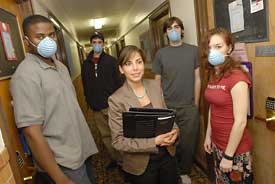If you happen to see a long line of students wearing surgical masks emerging from a U-M residence hall in the next few weeks, there’s no need to panic.

More than 2,000 students in University housing are taking part in a study this winter to figure out whether masks truly help prevent the spread of influenza, or if they just look odd without doing anything.
Though washing hands and wearing masks are recommended widely as approaches that might prevent the spread of a global killer influenza, apparently no one actually has any data on whether they work, says study leader Arnold Monto, professor of epidemiology in the School of Public Health (SPH) and an international authority on respiratory disease.
“There is some anecdotal evidence from prior pandemic outbreaks that masks may have helped, but no firm data,” he says.
With $1.3 million in grant funding from the U.S. Centers for Disease Control and Prevention, the study is timed to coincide with the arrival of seasonal influenza on campus. The residence halls, where students share sleeping quarters, bathrooms, hallways and dining areas, are ideal laboratories for tracking the spread of airborne viruses.
SPH will be handing out 800 cases of alcohol-based hand sanitizer—2 ounces for the backpack, and an 8-ounce pump for the dorm room—and thousands of cotton masks that are held on by rubber bands over the ears.
At Bursley Hall, students will use hand sanitizer and wear the simple cotton surgical masks. In Couzens, Alice Lloyd, Betsey Barbour and Helen Newberry, students will use only the masks. In East Quad and Stockwell, students won’t use either measure but will participate in regular online surveys and testing if they start to show symptoms.
At the end of the study, the numbers will be crunched to see whether influenza was deterred by the different behaviors.
The hand sanitizer use will begin as soon as there is a confirmed case of influenza in a dorm on campus. The masks will go into effect when a true outbreak is detected, and will stay in use for about six weeks.
Overcoming the social stigma of being seen in a mask may be the study’s biggest hurdle, acknowledges co-investigator Allison Aiello, assistant professor of epidemiology, who says, “It’s going to be a group effort, that’s for sure.”
Students are expected to wear the masks all the time when they’re in the dorm, but other locations are optional. “We’d like them to be worn all the time, but we didn’t think that was feasible,” study coordinator Amanda Harrier says.
Not everyone in the residence halls will be involved, but participating students will receive $30 to $100 for their help, depending on how many parts of the study they encounter. Getting sick and having a throat swab for a specimen is worth an extra $25, for example. The students have not been told whether or not to get flu shots, Aiello says.
In addition to the masks and hand sanitizer, study participants will be armed with stickers and magnets describing flu symptoms and bearing a pager number. Should a student report something that looks like flu, Harrier will scramble a nurse to the dorm to do a mini-clinic and collect samples.
While a global pandemic flu is not expected to emerge this year, the ordinary seasonal flu is nothing to sneeze at, study leaders say. Seasonal influenza kills about 36,000 Americans each year, twice the toll of the human immunodeficiency virus/AIDS.
Regardless of which influenza arrives this season, the U-M Health Service strongly recommends that everyone obtain a flu vaccination, either the shot or the FluMist nasal spray. U-M Housing and the health service have worked together closely for several years to teach students how to avoid illness.
For more information go to www.uhs.umich.edu/services/flu.html.

